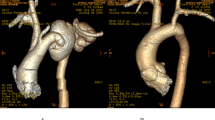Abstract
We report herein the rare case of a 79-year-old man who suffered permanent paraplegia after undergoing an otherwise successful total arch replacement for a ruptured aortic arch aneurysm. During cardiopulmonary bypass, perfusion to the distal aorta was maintained from the femoral artery, and postoperative aortography showed intact tributaries from the aorta including the intercostal arteries. Postoperative paraplegia is an extremely rare complication of operations on the aortic arch; however, we speculate that the paraplegia in this patient could be attributed either to a steal phenomenon involving the radicular artery, or to the anatomical particularity of the spinal cord artery described by Cole and Gutelius as the “segmental system.”
Similar content being viewed by others
References
Cole PT, Gutelius JR (1969) Neurologic complication of operations on the descending thoracic aorta. Can J Surg 12:435–443
Connolly JE (1986) Prevention of paraplegia secondary to operations on the aorta. J Cardiovasc Surg 27:410–417
Seibel P, Scott TP, Kron IL, Tribble CG (1993) Regional adenosine attenuates postischemic spinal cord injury. J Vasc Surg 18:153–160
Massimo CG, Poma AG, Viligiardi RR, Duranti A, Colucci M, Favi PP (1986) Simultaneous total aortic replacement from arch to bifurcation: experience with six cases. Tex Heart Inst J 13:147–151
Lawrence GH, Hessel EA, Sauvage LA, Krause AH (1977) Results of the use of TDMAC-heparin shunt in the surgery of aneurysms of the descending thoracic aorta. J Thorac Cardiovasc Surg 73:393–398
Zacharopoulous L, Symbas PN (1983) Internal temporary aortic shunt for managing lesions of the descending thoracic aorta. Ann Thorac Surg 35:240–242
Laschinger JC, Cunningham JN Jr, Nathan IM, Knopp EA, Cooper MM, Spencer FC (1983) Experimental and clinical assessment of the adequacy of partial bypass in maintenance of spinal cord blood flow during operations on the thoracic aorta. Ann Thorac Surg 36:417–426
Wadouh F, Arndt CF, Oppermann E, Borst HG, Wadouh R (1986) The mechanism of spinal cord injury after simple and double aortic cross-clamping. J Thorac Cardiovasc Surg 92:121–127
Rose DM, Jacobowitz IJ, Acinapura AJ, Cunningham JN Jr (1984) Paraplegia following percutaneous insertion of an intraaortic balloon. J Thorac Cardiovasc Surg 87:788–789
Author information
Authors and Affiliations
Rights and permissions
About this article
Cite this article
Hadama, T., Mori, Y., Shigemitsu, O. et al. Repair of a ruptured aortic arch aneurysm complicated by postoperative paraplegia: Report of a case. Surg Today 26, 60–63 (1996). https://doi.org/10.1007/BF00311995
Received:
Accepted:
Issue Date:
DOI: https://doi.org/10.1007/BF00311995




